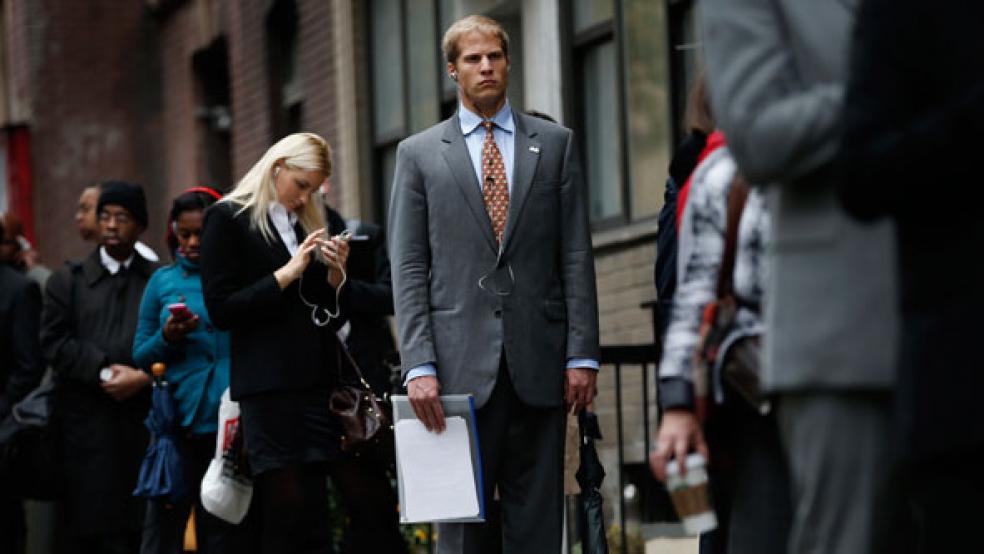Fasten your seat belts. Washington and Wall Street are about to be thrown into their usual tizzy by the Friday jobs report.
Shortly after the 8:30 a.m. release of the April employment figures, the stock market will register its pleasure or frustration. Then GOP congressional leaders will denounce—no surprise—the policies of President Obama. And finally, the White House will emphasize how steady the recovery has been from the depths of the recession, while noting that additional steps are needed.
This happens every month. After all the fuss about one economic snapshot—which is prone to massive revisions over the next two months—public attention quickly turns to the next story du jour.
The myopia is a huge problem. All the hype on the unemployment rate has obscured more troubling phenomena about a U.S. economy that no longer cranks out jobs like it once did. Politicians, investors, and journalists often emphasize whether the monthly jobs report met expectations—which for April happens to be a 148,000-increase to payrolls.
“Collectively, there has been a fixation with the month to month gyrations to the detriment of the longer-term trends,” said Patrick O’Keefe, director of economic research at Cohn Reznick and a former deputy assistant Labor secretary.
The 7.6 percent unemployment rate suggests improvement. But the share of Americans in the labor force has declined for the past 13 years to 63.3 percent, a percentage last seen when Jimmy Carter occupied the White House and women were still flooding the job market. Entire careers have been replaced by new technology or offshored to countries that pay lower wages, while more and more resumes from new college graduates go unanswered.

RELATED: Graduate from Law School, Pass the Bar, Get Unemployment
“In a globally competitive world, we have a labor market that is still organized around the post-World War II experience,” O’Keefe said. “Right now, we are watching a large cohort of young adults—almost as large as the baby boomers—enter a workforce where there is little opportunity for them.”
In response to the disappointing 88,000 jobs generated in March, House Majority Leader Eric Cantor, R-Va., did cite the labor force participation stat. But Cantor used it to pin the blame on Obama for not fixing job-training programs, even though the decline dates back to when the president was a relatively unknown Illinois state senator in the middle of a failed primary campaign for Congress.
Both sides resort to traditional political positions for an economy that is behaving differently than it has in the past. The Obama administration calls each month for more government spending on infrastructure, while GOP lawmakers seize on the report as proof that a simpler tax code is needed.
What gets overlooked in the political tit-for-tat are the fundamental patterns in the U.S. economy, not just structural questions about the labor force but cyclical ones unique to this recovery.
For the past three years, job growth tends to be strong in the months around the winter and then weaken sometime in the spring. An individual jobs report can be subject to the whims of the weather, rather than policies from Washington. Ryan Wang, the U.S. economist for the bank HSBC, noted that an unseasonably cold March slowed down hiring, such that only 88,000 jobs were added instead of the expected 200,000.
Or, for example, consider the slowdown in how many new jobs produced each month. Unlike the monthly jobs number that is calculated by subtracting lay-offs from new hires, this figure focuses exclusively on gross job creation. Between 2004 and 2007, the average was 5 million jobs a month. In 2012, it was 4.3 million a month, a difference of 700,000.
When Congress does try to drill down on bigger questions about the economy, it can happen at sparsely attended committee hearings. This was exemplified last week at a Joint Economic Committee hearing about the long-term unemployed. A photo taken by a National Journal reporter showed that few lawmakers bothered to attend, a shocking incongruity given how often politicians profess to care about the jobs crisis.
The hearing detailed the plight of 4.6 million Americans who have been unemployed for more than six months, a tipping point at which their skills erode and they become less likely to be hired. If these Americans cannot return to the workforce, it puts more of a burden on government programs and limits the ability of the economy to grow.
Minnesota Sen. Amy Klobuchar, the Democratic vice chairwoman of the committee who convened the hearing, talked about the need for better job training, although their seems to be little momentum for bipartisan agreement despite Cantor’s comments following the March employment report.
One of the obstacles is that not every lawmaker wants the government to have deeper insights into the state of the economy.
Rep. Jeff Duncan, R-SC, introduced a bill last week with 10 co-sponsors to eliminate parts of the Census, including the American Community Survey that provides economic, demographic, and social data that is crucial for understanding the job market. House Republicans voted last year to kill the ACS, but their bill failed to pass the Democratic majority Senate.
“The ACS provides reliable statistics that are indispensable to anyone who has to make informed decisions about the future,” the Census Bureau said. “These statistics are required by all levels of government to manage or evaluate a wide range of programs, but are also useful for research, education, journalism, business and advocacy.”
Duncan called the Census survey “legalized government harassment” in this second attempt.
“I recognize that some economic data gathering is beneficial,” Duncan said in a statement. “However, it should be voluntary, industry driven, and not mandated by the government under penalty of law.”



